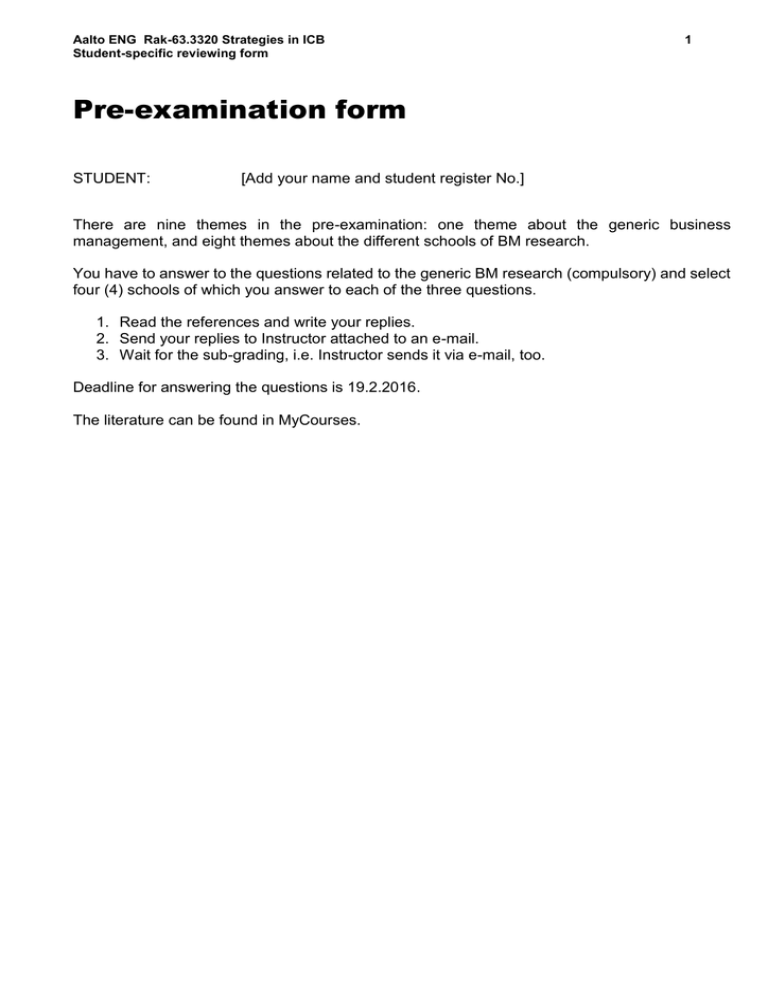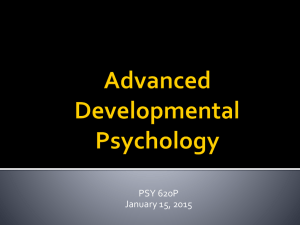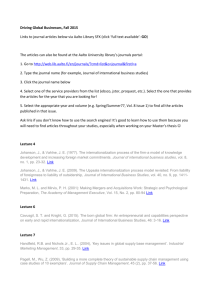Rak-63_3320_pre-examination form
advertisement

Aalto ENG Rak-63.3320 Strategies in ICB Student-specific reviewing form 1 Pre-examination form STUDENT: [Add your name and student register No.] There are nine themes in the pre-examination: one theme about the generic business management, and eight themes about the different schools of BM research. You have to answer to the questions related to the generic BM research (compulsory) and select four (4) schools of which you answer to each of the three questions. 1. Read the references and write your replies. 2. Send your replies to Instructor attached to an e-mail. 3. Wait for the sub-grading, i.e. Instructor sends it via e-mail, too. Deadline for answering the questions is 19.2.2016. The literature can be found in MyCourses. Aalto ENG Rak-63.3320 Strategies in ICB Student-specific reviewing form 2 LIST OF 1 COMPULSORY REVIEW AND 8 ALTERNATIVE SCHOOLSPECIFIC REVIEWS Compulsory review of Schools 1-8 of thought on generic BM Alternative review of School 1: Porterian BM Alternative review of School 2: Resource-based BM Alternative review of School 3: Competence-based BM Alternative review of School 4: Knowledge-based BM Alternative review of School 5: Organization-based BM Alternative review of School 6: Process-based BM Alternative review of School 7: Dynamism-based BM Alternative review of School 8: Evolutionary BM Aalto ENG Rak-63.3320 Strategies in ICB Student-specific reviewing form 3 COMPULSORY REVIEW OF SCHOOLS 1-8 OF THOUGHT ON GENERIC BM Reference files Questions for reviewing 0.1 Huovinen P. (2008) Platform for advancing research in competencebased BM: A population of 84 concepts published between 19902002. Research in CompetenceBased Management 4, 175-218. 44 p. Sub-review 0.1 How valid is Huovinen’s (2008) classification of 8 schools of thought on generic business management (BM) in the sphere of theoretical knowledge, by your assessment? Why this level of validity? 0.2 Huovinen P. (2013) Advancing IB ideation: A review of competencerelated management concepts published between 1990-2012. In Larimo J., et al., eds., Proceedings of 12th Vaasa Conference on IB. U. of Vaasa. 21-23 August 2013. 25 p. Sub-review 0.2 Along what dimension(s) and for what context(s) would you advance international business (IB) management concepts in the future? Why this/these dimension(s) and contexts? You may choose contexts that are outside or inside capital (incl. construction and real estate) investment markets. 0.3 Huovinen P. (26 Nov 2014 ) Theoretical 71-concept platform for advancing construction-related BM. Manuscript for 8th Nordic Conference on Construction Economics and Management. TUT, RIL, and CREON. Tampere. 27-29 May 2015. 8 p. Sub-review 0.3 What kind of international construction business (ICB) management concepts are the most useful (or effective or applicable) ones in focal contexts embedded within capital (including construction and real estate) investment markets, based on your reflection? Why these concepts? Do please reply to each of 3 questions herein: Sub-review 0.1 Sub-review 0.2 Sub-review 0.3 Aalto ENG Rak-63.3320 Strategies in ICB Student-specific reviewing form 4 ALTERNATIVE REVIEW OF SCHOOL 1: PORTERIAN BM Reference files Questions for reviewing 1.1 Porter, M. E. (1994) Toward a dynamic theory of strategy. In: Rumelt, R.P., Schendel, D. E. and Teece, D. J. (Eds.) Fundamental issues in strategy. Harvard Business School Press, Boston, MA, 423-461. 39 p. Sub-review 1.1 How theoretically advanced is this Porterian BM school with its determinants of success (Fig. 152), by your assessment? Why so highly or less advanced? You may also assess advancement as Porter’s outlines of a dynamic theory of strategy (p. 424). 1.2 Heracleous, L. (2013) Quantum strategy at Apple Inc. Organizational Dynamics, Vol. 42, 92-99. 8 p. Sub-review 1.2 Along which dimension(s) and for which focal context(s) would you further advance this Quantum Strategy in the future? Why this/these, respectively? You may also choose the same dimensions that appear in Table 1 and Figures 3-4. You may choose contexts that are outside or inside capital (incl. construction and real estate) investment markets. 1.3 Roulac, S. E. (2001) Corporate property strategy is integral to corporate business strategy. Journal of Real Estate research, Vol. 22, Nos 1/2, 129-152. 24 p. Sub-review 1.3 Do please choose one or more focal contexts of your own from among contexts embedded within capital (including construction and real estate) investment markets. (i) Which real estate strategies and which aspects of places and spaces (see Exhibits) mostly contribute to a firm’s competitive advantage with your focal context and (ii) how would you further apply (or tailor or adapt) these elements to this end? You may choose also Roulac’s (2001) context. Do please reply to each of 3 questions herein: Sub-review 1.1 Sub-review 1.2 Sub-review 1.3 Aalto ENG Rak-63.3320 Strategies in ICB Student-specific reviewing form 5 ALTERNATIVE REVIEW OF SCHOOL 2: RESOURCE-BASED BM Reference files Questions for reviewing 2.1A Barney, J. B. and Hesterly W. S., eds. (2008) Strategic management and competitive adventage – Concepts and cases. 2nd ed. Pearson International Education/Prentice Hall, Ch. 1 (4-5, 1014) and Ch. 3 (74-107). 34 p. 2.1B Barney, J. B., Ketchen Jr., D. J., and Wright, M. (2011) The future of resource-based theory: Revitalization or decline? Journal of Management, Vol. 37, No. 5, 1299-1315. 17 p. 2.2 Möller, K., Rajala, R., and Westerlund, M. (2008) Service innovation myopia? A new recipe for client-provider value creation. California Management Review, Vol. 50, Spring, 31-48. 18 p. Sub-review 2.1 How theoretically advanced 2.3 Johnsson, H. (2011) The building system as a strategic asset in industrialized construction. In: Haugbolle, K. et al. (Eds.), Proceedings of 6th Nordic Conference on Construction Economics and Organisation. Vol. 3 (pp. 541-552). Aalborg, Denmark: Danish Building Research Institute and Aalborg University. 12 p. is this resource-based BM school based on Barney and Hesterly’s (2008) RBV, VRIO, and implications as well as on Barney et al.’s (2011) RBT’s accomplishments, challenges, and five themes, by your assessment? Why so highly or less advanced? Sub-review 2.2 In which area(s) and for which focal context(s) would you further derive maximum value from service innovations in the future? Why this/these, respectively? You may also choose the same three areas of strategy, co-creation, capabilities, culture and mindset (p. 45) and/or three modes of activity (Table 2). You may choose contexts that are outside or inside capital (incl. construction and real estate) investment markets. Sub-review 2.3 Do please choose one or more focal context(s) of your own from among contexts embedded within capital (including construction and real estate) investment markets. How would you further develop or apply the 4 characteristics of a strategic asset (Table 1; Barney 1991) and/or 2 strategies (pp. 541, 548-549) for managing a business with your focal context? You may choose also Johnsson’s (2011) context. Do please reply to each of 3 questions herein: Sub-review 2.1 Sub-review 2.2 Sub-review 2.3 Aalto ENG Rak-63.3320 Strategies in ICB Student-specific reviewing form 6 ALTERNATIVE REVIEW OF SCHOOL 3: COMPETENCE-BASED BM Reference files Questions for reviewing 3.1 Sanchez, R. and Heene, A. (2004) The new strategic management. Organization, competition, and competence. Ch. 1 and 3-5 in part. Wiley. 20 p. Sub-review 3.1 How theoretically advanced is this competence-based BM school as Sanchez and Heene’s (2004) concept (1.4), perspective (preface, 2.4), and 6-element approach (3.2), by your assessment? Why so highly or less advanced? 3.2 Sanchez, R. (2004) Understanding competence-based management: Identifying and managing five modes of competence. Journal of Business Research, Vol. 57, 518-532. 15 p. Sub-review 3.2 Along which modes (out of I-V in Fig. 1) and for which focal context(s) would you apply Sanchez’ (2004) 5-mode competence concept in the future? Why this/these mode(s) and contexts? You may choose contexts that are outside or inside capital (incl. construction and real estate) investment markets. 3.3 Helander, A. and Möller, K. (2007) System supplier’s customer strategy. Industrial Marketing Management, Vol. 36, 719-730. 12 p. Sub-review 3.3 Do please choose one or more focal contexts of your own from among contexts embedded within capital (including construction and real estate) investment markets. (i) Which areas or elements of the dynamic model (Fig. 2), coupled with roles (Fig. 3), dynamics (Fig. 4), and knowledge gaps (Fig. 5) are the most useful (or effective or applicable) ones to managing a business with your focal context and (ii) how would you further apply (or tailor or adapt) these elements to this end? You may choose also Helander and Möller’s (2007) context. Do please reply to each of 3 questions herein: Sub-review 3.1 Sub-review 3.2 Sub-review 3.3 Aalto ENG Rak-63.3320 Strategies in ICB Student-specific reviewing form 7 ALTERNATIVE REVIEW OF SCHOOL 4: KNOWLEDGE-BASED BM Reference files Questions for reviewing 4.1 Easterby-Smith, M. and Lyles, M. A. (2011) The evolving field of organizational learning and knowledge management. Chapter 1 in Easterby-Smith, M. and Lyles, M. A., eds., Handbook of organizational learning & knowledge management. 2nd ed. Wiley, pp. 1-16 THIS CAN BE FOUND AS AN EBOOK FROM AALTO LIBRARY Sub-review 4.1 How theoretically advanced is this knowledge-based BM school based on the 4 areas of OLKM and future directions, by your assessment? Why so highly or less advanced? 4.2 Nonaka I., Toyama R. and Byosiere P. (2001) A theory of organizational knowledge creation: Understanding the dynamic process of creating knowledge. Chapter 22 in Dierkes M. et al., eds., Handbook of organizational learning and knowledge. Oxford University Press, 491-517. 27 p. Sub-review 4.2 How theoretically advanced is this “theory of organizational knowledge creation” as SECI, Ba, knowledge assets, OKC process management, and organizing, by your assessment? Why so highly or less advanced? 4.3 McDermott, R. and Archibald, D. (2010) Harnessing your staff’s informal networks. Harvard Business Review, vol. 88, March, 83-89. 7 p. Sub-review 4.3 Do please choose one or more focal contexts of your own from among contexts embedded within capital (including construction and real estate) investment markets. How would you further apply (or tailor or adapt) the concept and organizing principle (e.g. Fluor) of communities of practice in your focal context(s)? You may choose also McDermott and Archibald’s (2010) context(s). Do please reply to each of 3 questions herein: Sub-review 4.1 Sub-review 4.2 Aalto ENG Rak-63.3320 Strategies in ICB Student-specific reviewing form 8 Sub-review 4.3 ALTERNATIVE REVIEW OF SCHOOL 5: ORGANIZATION-BASED BM Reference files Questions for reviewing 5.1 Bartlett, C. A. and Ghoshal, S. (1998, 2002) Managing across borders - the transnational solution. Ch. 4. Century Business, 57-71. 15 p. Sub-review 5.1 What founding, insightful role does the transnational solution (Tables 4.2-4.3) occupy within this organization-based BM school and in particular with MNCs’ contexts, by your assessment? Why the highly or less significant one? 5.2 Fourne, S. P. L., Jansen, J. J. P. and Mom, T. J. M. (2014) Strategic agility in MNEs. California Management Review, Vol. 56, Spring, 13-38. 25 p. Sub-review 5.2 In which area(s) and for which focal context(s) would you further advance and apply Strategic Agility in terms of drivers, a meta-capability, and three dynamic capabilities (Fig. 1 and Table 1) in the future? Why this/these, respectively? You may choose contexts that are outside or inside capital (incl. construction and real estate) investment markets. 5.3 Wikström, K., Artto, K., Kujala, J., and Söderlund, J. (2010) Business models in project business. International Journal of Project Management, Vol. 28, 832-841. 10 p. Sub-review 5.3 Do please choose one or more focal contexts of your own from among contexts embedded within capital (including construction and real estate) investment markets. How would you further apply (or tailor or adapt) the five elements (Table 2) and the categories I, II, and III (Table 3) of business models to your focal context(s)? You may choose also Wikström et al.’s (2010) context(s). Do please reply to each of 3 questions herein: Sub-review 5.1 Sub-review 5.2 Sub-review 5.3 Aalto ENG Rak-63.3320 Strategies in ICB Student-specific reviewing form 9 ALTERNATIVE REVIEW OF SCHOOL 6: PROCESS-BASED BM Reference files Questions for reviewing 6.1A Johanson, J. and Vahlne, J.-E. (1977) The internationalization process of the firm – A model of knowledge. Journal of International Business Studies, Vol. 8, Spring, 2332. 12 p. 6.1B Johanson, J. and Vahlne, J.-E. (2009) The Uppsala internationalization process model revisited. Journal of International Business Studies, Vol. 40, 14111431. 20 p. 6.2 Hatten, K. J. and Rosenthal, S. R. (1999) Managing the processcentred enterprise. Long Range Planning 32(3), 293-310. 17 p. Sub-review 6.1 How theoretically advanced is this internationalization process sub-school based on the 1977 model and mechanism (Fig. 1) and the 2009 business network internationalization process model (Fig. 2), by your assessment? Why so highly or less advanced? Sub-review 6.2 By which elements and for which focal context(s) would you theoretically advance Enterprise Model (Figures 1-4) in the future? Why these elements and contexts? You may choose contexts that are outside or inside capital (incl. construction and real estate) investment markets. 6.3 Salonen, A., Gabrielsson, M., Sub-review 6.3 Do please choose one or and Al-Obaidi, Z. (2006) Systems more focal contexts of your own from sales as a competitive response to among contexts embedded within capital the Asian challenge: Case of a global (including construction and real estate) ship power supplier. Industrial investment markets. (i) Which elements Marketing Management, Vol. 35, of the systems and process models 740-750. 11 p. (Figures 1-3) are the most useful (or effective or applicable) ones to managing a business with your focal context and (ii) how would you further apply (or tailor or adapt) these elements to this end? You may choose also Salonen et al.’s (2006) context(s). Do please reply to each of 3 questions herein: Sub-review 6.1 Sub-review 6.2 Sub-review 6.3 Aalto ENG Rak-63.3320 Strategies in ICB Student-specific reviewing form 10 ALTERNATIVE REVIEW OF SCHOOL 7: DYNAMISM-BASED BM Reference files 7.1A Prahalad, C. K. and Hamel, G. (1990) The core competence of the corporation. Harvard Business Review, Vol. 68, May-June, 79-91. 13 p. 7.1B Hamel, G. and Välikangas, L. (2003) The quest for resilience. Harvard Business Review, Vol. 82, September, 52-63. 12 p. 7.2 Storbacka, K. (2011) A solution business model: Capabilities and management practices for integrated solutions. Industrial Marketing Management, Vol. 40, 699-711. 12 p. Questions for reviewing Sub-review 7.1 How theoretically advanced is this dynamism-based subschool based on the 1990 core competence (Fig. 1) and the 2003 resilience capacity as one of innovation forms (p. 55) with the anticipation of business strategies decaying in 4 ways, by your assessment? Why so highly or less advanced? Sub-review 7.2 By which elements and for which focal context(s) would you theoretically advance the solution business framework (Fig. 1) with the enabling capabilities and management practices (Table 2) in the future? Why these elements and contexts? You may choose contexts that are outside or inside capital (incl. construction and real estate) investment markets. 7.3 Lampel, J. (2001) The core Sub-review 7.3 Do please choose one or competencies of effective project more focal contexts of your own from execution: The challenge of diversity. among contexts embedded within capital International Journal of Project (including construction and real estate) Management, Vol. 19, 471-483. 13 p. investment markets. (i) Which elements and characteristics of a firm’s core processes and competencies (Fig. 1), EPC competencies (Table 1), and strategies of EPC firms (Table 2) are the most useful (or effective or applicable) ones to managing a business with your focal context and (ii) how would you further apply (or tailor or adapt) these elements to this end? You may choose also Lampel’s (2001) context(s). Do please reply to each of 3 questions herein: Sub-review 7.1 Sub-review 7.2 Sub-review 7.3 Aalto ENG Rak-63.3320 Strategies in ICB Student-specific reviewing form 11 ALTERNATIVE REVIEW OF SCHOOL 8: EVOLUTIONARY BM Reference files 8.1 Burgelman, R. (2014) Built to become: Corporate longevity and strategic leadership. Stanford University. Working Paper Series # 3115. 40 p. Questions for reviewing Sub-review 8.1 How theoretically advanced are the strategy diamond framework (Appendix 2) and the strategic leadership framework for examining and explaining corporate becoming as well as involving the key tasks and the 4 element of a company’s strategic leadership capability (e.g. internal ecology strategymaking (Appendix 3), by your assessment? Why so highly or less advanced? 8.2A Teece, D. J., Pisano, G. and Sub-review 8.2 Along which Shuen, A. (1997) Dynamic dimension(s) and for which focal capabilities and strategic context(s) would you further advance management. Strategic Management and apply the 1990/ 1997 dynamic Journal, Vol. 18, No. 7, 509-533. 25 capabilities framework (pp. 515-526; the p. 4th paradigm in Table 1) and IBM’s 8.2B Harreld, J. B., O’Reilly III, C. A. dynamic capabilities (pp. 33-41) in the and Tushman, M. L. (2007) Dyn-amic future? Why this/these, respectively? capabilities at IBM: Driving strategy You may choose contexts that are into action. California Management outside or inside capital (incl. Review, Vol. 49, No. 4, 21-43. 23 p. construction and real estate) investment markets. 8.3 Gebauer, H. (2011) Exploring the Sub-review 8.3 Do please choose one or contribution of management more focal contexts of your own from innovation to the evolution of among contexts embedded within capital dynamic capabilities. Industrial (including construction and real estate) Marketing Management, Vol. 40, investment markets. How would you 1238-1250. 13 p. further apply (or tailor or adapt) the parts of the conceptual framework (Fig. 1) and management innovations facilitating the sensing, seizing, and reconfiguration (Tables 3-4) to focal context(s)? You may choose Gebauer’s (2011) context(s). Do please reply to each of 3 questions herein: Sub-review 8.1 Sub-review 8.2 Sub-review 8.3






